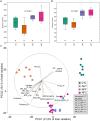Enhancing rumen microbial diversity and its impact on energy and protein metabolism in forage-fed goats
- PMID: 38179333
- PMCID: PMC10764530
- DOI: 10.3389/fvets.2023.1272835
Enhancing rumen microbial diversity and its impact on energy and protein metabolism in forage-fed goats
Abstract
Introduction: This study explores if promoting a complex rumen microbiota represents an advantage or a handicap in the current dairy production systems in which ruminants are artificially reared in absence of contact with adult animals and fed preserved monophyte forage.
Methods: In order to promote a different rumen microbial diversity, a total of 36 newborn goat kids were artificially reared, divided in 4 groups and daily inoculated during 10 weeks with autoclaved rumen fluid (AUT), fresh rumen fluid from adult goats adapted to forage (RFF) or concentrate (RFC) diets, or absence of inoculation (CTL). At 6 months of age all animals were shifted to an oats hay diet to determine their ability to digest a low quality forage.
Results and discussion: Early life inoculation with fresh rumen fluid promoted an increase in the rumen overall microbial diversity which was detected later in life. As a result, at 6 months of age RFF and RFC animals had higher bacterial (+50 OTUs) and methanogens diversity (+4 OTUs) and the presence of a complex rumen protozoal community (+32 OTUs), whereas CTL animals remained protozoa-free. This superior rumen diversity and presence of rumen protozoa had beneficial effects on the energy metabolism allowing a faster adaptation to the forage diet, a higher forage digestion (+21% NDF digestibility) and an energetically favourable shift of the rumen fermentation pattern from acetate to butyrate (+92%) and propionate (+19%) production. These effects were associated with the presence of certain rumen bacterial taxa and a diverse protozoal community. On the contrary, the presence of rumen protozoa (mostly Entodinium) had a negative impact on the N metabolism leading to a higher bacterial protein breakdown in the rumen and lower microbial protein flow to the host based on purine derivatives urinary excretion (-17% to -54%). The inoculation with autoclaved rumen fluid, as source of fermentation products but not viable microbes, had smaller effects than using fresh inoculum. These findings suggest that enhancing rumen microbial diversity represents a desirable attribute when ruminants are fed forages in which the N supply does not represent a limiting factor for the rumen microbiota.
Keywords: energy metabolism; forage digestion; multi-kingdom; protein metabolism; protozoa; rumen microbiota; ruminants.
Copyright © 2023 Belanche, Palma-Hidalgo, Jiménez and Yáñez-Ruiz.
Conflict of interest statement
The authors declare that the research was conducted in the absence of any commercial or financial relationships that could be construed as a potential conflict of interest. The author(s) declared that they were an editorial board member of Frontiers, at the time of submission. This had no impact on the peer review process and the final decision.
Figures



References
-
- Yeoman CJ, Ishaq SL, Bichi E, Olivo SK, Lowe J, Aldridge BM. Biogeographical differences in the influence of maternal microbial sources on the early successional development of the bovine neonatal gastrointestinal tract. Sci Rep. (2018) 8:3197–14. doi: 10.1038/s41598-018-21440-8, PMID: - DOI - PMC - PubMed
LinkOut - more resources
Full Text Sources
Research Materials

